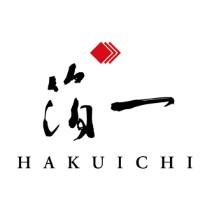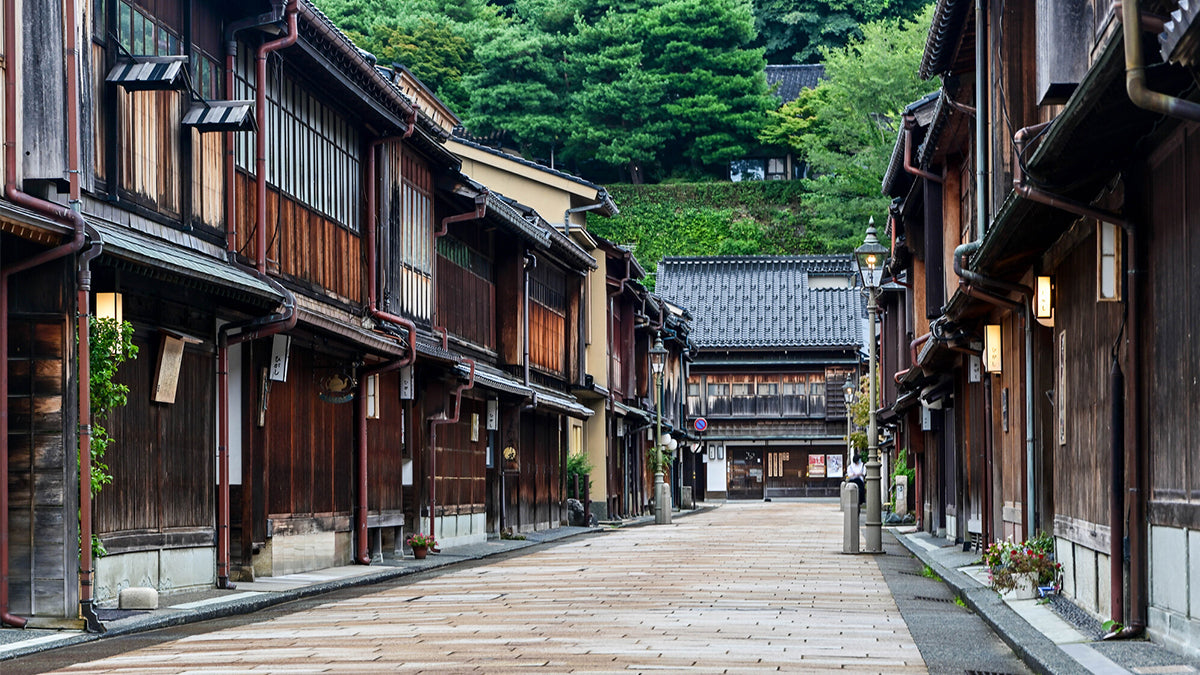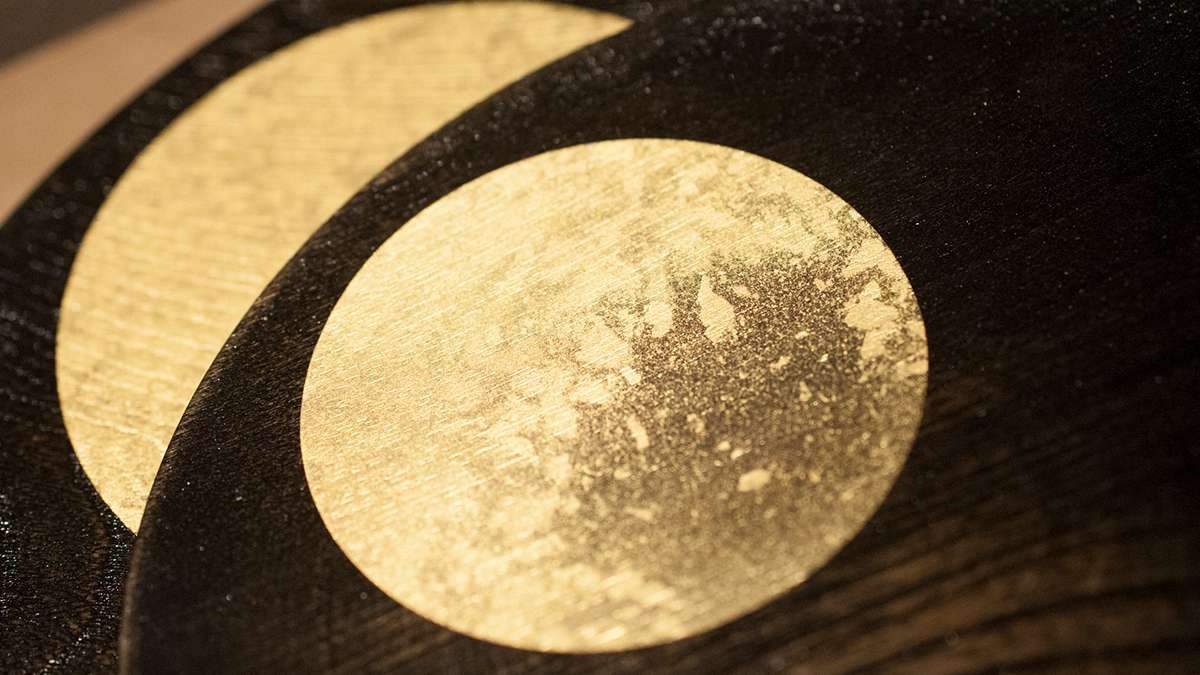

Japanese Gold Leaf Art & Dinnerware
Ishikawa-Chubu

Area
A Picturesque Setting for Gold Leaf
The headquarters of Hakuichi is situated in the heart of Kanazawa in Ishikawa prefecture. Its modern structure belies its traditional approach to handicrafts and the rich cultural history of the surrounding community — a community that has grown steadily to 900 craft businesses employing 3,000 people who produce 22 official traditional crafts.
Kanazawa, recognized as a Creative City by UNESCO, has lived peacefully and avoided natural disasters for centuries. As a result, the old samurai district around Kanazawa Castle and Kenrokuen Gardens still radiates a historical charm with narrow alleys, earthen walls and cobblestone surfaces. And the historical wooden teahouses nearby let us drift back to an era when geishas entertained their powerful samurai clients.

History
A Community Rich in Arts and Culture
The handicraft culture in Kanazawa today can be traced back to the rich and powerful Maeda clan in the 16th century. Viewed as a potential threat to the ruling shogun, they carefully avoided military conflict and invested heavily in arts and culture, attracting artisans from around Japan and building an appreciation for the arts that continues around the city today.
The Maeda clan also ordered the production of gold leaf, or “kinpaku,” thus launching this 400-year-old industry. Not long afterward, though, the shogun strictly limited production to a few select places that did not include Kanazawa. However, the industry continued quietly out of public view, and production was able to resume quickly as rules were relaxed. The area is also blessed with ideal humidity and water quality, and today Kanazawa dominates with an astounding 99% of the gold leaf market.
Hakuichi was founded in 1975 by Kuniko Asano, who was committed to raising the profile of Kanazawa gold leaf as a recognizable brand, not just a commodity material. Following this strategy, Hakuichi began not only producing gold leaf but also traditional handicrafts featuring gold leaf. Hakuichi also discovered that hemp paper, previously thrown away during production, was highly absorbent ー so they smartly transformed the paper into a popular product to remove oil from the face. Today, Hakuichi produces a broad range of traditional handicrafts, cosmetic products and edible gold leaf in addition to their materials business.

Characteristic
Traditional Techniques for a Modern World
The breadth and depth of craftsman skills at Hakuichi to make gold leaf materials and handicrafts are truly impressive. Consider the complex journey of a gold nugget as it’s progressively hammered into a gold sheet of an incredible 0.0001 mm thickness. For perspective, household aluminum foil is typically 0.0160 mm, or 160 times thicker than a handmade gold leaf. Each step is done by a specialized craftsman who can handle the fragile sheets without damage from tools, static electricity or even heavy breathing.
Hakuichi actively promotes gold leaf to a broad community across Japan, including not only artisans from many industries but also the general public with a curiosity about gold leaf. As well as conducting regular workshops, Hakuichi recently built a museum where visitors can learn about traditional techniques and experience handling a delicate gold leaf themselves.
Hakuichi has long embraced the concept of SDGs (Sustainable Development Goals). In fact, their popular oil blotting paper was originally a waste by product that was changed into a hit consumer product, thereby helping the environment. They also make seasonal products from discarded wood generated as local forests are thinned to encourage new growth. And Hakuichi also embraces the Japanese concept of “kintsugi,” whereby damaged handicrafts are repaired with gold to highlight imperfections as a welcome feature.

For Customers
Creating Moments of Beauty and Luxury
Hakuichi offers many practical ways to infuse the luxury of gold into our everyday lifestyles. Whether to inspire or relax, its effect is undoubtedly dramatic.
Artwork can completely change the ambiance of any room at home or work. This is especially true for Hakuichi art panels with bold yet simple designs when displayed against a dark background. The square shapes and gold colors have a distinctively modern feel that complements a broad range of room interiors. These artwork panels have a subtle Japanese style that comfortably blends with any decor. Ultimately, artwork is about emotion, so consider which Hakuichi panel inspires you.
Handicrafts infused with gold can turn everyday moments into memorable moments with family or friends. Hakuichi tableware products add an artistic flair to any gathering, whether it’s the broken gold pattern of Penetration glasses or the stirring gold moon of Oborotsuki plates. Afterward, personal moments can also become more relaxed as you quietly reflect in the midst of soft gold colors. Whatever your lifestyle, a Hakuichi handicraft is sure to capture your heart.
Award
2005 Ministry of Economy, Trade and Industry - 1st Manufacturing Award Excellence Award
2008 Good Design Award
2009 36th Ishikawa Design Exhibition - Ishikawa Governor's Award
2013 Ishikawa Traditional Crafts Fair - Grand Prix Award











![[Small Bowl] OLD KUTANI Pattern 2.83inch Kutani Porcelain Bowl | Kanazawa Gold Leaf | HAKUICHI](http://store.jtbusa.com/cdn/shop/products/s0009-213-1_{width}x.jpg?v=1710218101)
![[Small Bowl] OLD KUTANI Pattern 2.83inch Kutani Porcelain Bowl | Kanazawa Gold Leaf | HAKUICHI](http://store.jtbusa.com/cdn/shop/products/s0009-213-5_{width}x.jpg?v=1710279001)
![[Small Bowl] Yoshidaya Pattern 2.83inch Kutani Porcelain Bowl | Kanazawa Gold Leaf | HAKUICHI](http://store.jtbusa.com/cdn/shop/products/s0009-214-1_{width}x.jpg?v=1710218124)
![[Small Bowl] Yoshidaya Pattern 2.83inch Kutani Porcelain Bowl | Kanazawa Gold Leaf | HAKUICHI](http://store.jtbusa.com/cdn/shop/products/s0009-214-4_{width}x.jpg?v=1710278149)
![[Small Bowl] SHOZO Pattern 2.83inch Kutani Porcelain Bowl | Kanazawa Gold Leaf | HAKUICHI](http://store.jtbusa.com/cdn/shop/products/s0009-215-1_{width}x.jpg?v=1710218145)
![[Small Bowl] SHOZO Pattern 2.83inch Kutani Porcelain Bowl | Kanazawa Gold Leaf | HAKUICHI](http://store.jtbusa.com/cdn/shop/products/s0009-215-7_{width}x.jpg?v=1710278215)
![[Small Bowl] BLUE GRAIN Pattern 2.83inch Kutani Porcelain Bowl | Kanazawa Gold Leaf | HAKUICHI](http://store.jtbusa.com/cdn/shop/products/s0009-216-1_{width}x.jpg?v=1710218166)
![[Small Bowl] BLUE GRAIN Pattern 2.83inch Kutani Porcelain Bowl | Kanazawa Gold Leaf | HAKUICHI](http://store.jtbusa.com/cdn/shop/products/s0009-216-4_{width}x.jpg?v=1710278249)






























































![[Tumbler/Cup] Mt FUJI Cup Blue | Kanazawa Gold Leaf | HAKUICHI](http://store.jtbusa.com/cdn/shop/products/s0009-190-1_{width}x.jpg?v=1710217915)
![[Tumbler/Cup] Mt FUJI Cup Blue | Kanazawa Gold Leaf | HAKUICHI](http://store.jtbusa.com/cdn/shop/products/s0009-190-2_{width}x.jpg?v=1710217915)
![[Tumbler/Cup] Mt FUJI Cup Red | Kanazawa Gold Leaf | HAKUICHI](http://store.jtbusa.com/cdn/shop/products/s0009-191-1_{width}x.jpg?v=1710217932)
![[Tumbler/Cup] Mt FUJI Cup Red | Kanazawa Gold Leaf | HAKUICHI](http://store.jtbusa.com/cdn/shop/products/s0009-191-2_{width}x.jpg?v=1710217932)
![[Tumbler/Cup] KAGA SHIKISAI Deep Blue | Kanazawa Gold Leaf | HAKUICHI](http://store.jtbusa.com/cdn/shop/products/s0009-193-1_{width}x.jpg?v=1710217948)
![[Tumbler/Cup] KAGA SHIKISAI Deep Blue | Kanazawa Gold Leaf | HAKUICHI](http://store.jtbusa.com/cdn/shop/products/s0009-193-2_{width}x.jpg?v=1710217948)
![[Tumbler/Cup] KAGA SHIKISAI Sepia | Kanazawa Gold Leaf | HAKUICHI](http://store.jtbusa.com/cdn/shop/products/s0009-194-1_{width}x.jpg?v=1710217961)
![[Tumbler/Cup] KAGA SHIKISAI Sepia | Kanazawa Gold Leaf | HAKUICHI](http://store.jtbusa.com/cdn/shop/products/s0009-194-2_{width}x.jpg?v=1710217961)
![[Tumbler/Cup] KAGA SHIKISAI Water Blue | Kanazawa Gold Leaf | HAKUICHI](http://store.jtbusa.com/cdn/shop/products/s0009-195-1_{width}x.jpg?v=1710217975)
![[Tumbler/Cup] KAGA SHIKISAI Water Blue | Kanazawa Gold Leaf | HAKUICHI](http://store.jtbusa.com/cdn/shop/products/s0009-195-2_{width}x.jpg?v=1710217975)





